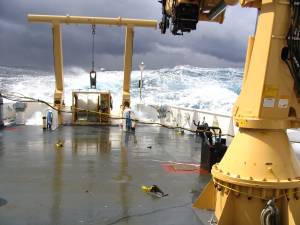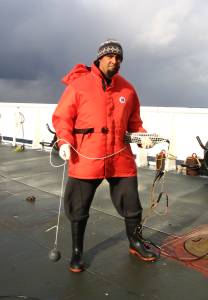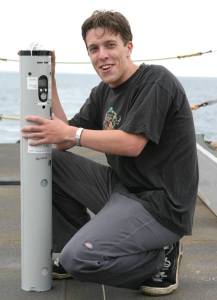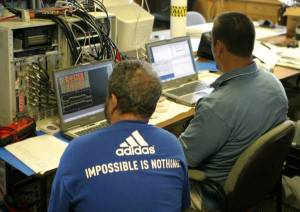ASA/NOISE-CON 2005 Meeting, Minneapolis, MN



Communicating Underwater Using Natural Ocean Noise
Dennis F. Jones - (email for media inquiries: atl.media@drdc-rddc.gc.ca)Defence R&D Canada - Atlantic
P.O. Box 1012
Dartmouth, N.S., Canada
B2Y 3Z7
Popular version of paper 5aSP5
Presented Friday morning, Oct 21, 2005
ASA/NOISE-CON Meeting, Minneapolis, MN
|
1. Introduction
Autonomous underwater surveillance systems are being developed at DRDC Atlantic to monitor Canadian coastal areas for intruders entering our territorial waters using surface and subsurface vessels. System components may include line arrays of hydrophones, networks of independent bottom-mounted sensor nodes, variable buoyancy gateway buoys, and autonomous underwater vehicles. Underwater acoustic modems will be needed for inter-component communications. In some cases, the performance requirements are not overly burdensome, for example, communication ranges less than 500 m and short messages containing basic target information such as bearing, range, depth, and time. One option under consideration for this short-range, low data rate application is a new noise-based acoustic communications approach. Unlike conventional communication modulation techniques that represent binary digits (bits) by step changes in the amplitude, frequency or phase of a signal, the current technique uses the natural noise in the ocean as bits—there is no signal. This is accomplished by transmitting a broadband noise mask with silent frequency bands. These silent bands 'fill in' with natural underwater noise as the transmission travels through the water to the receiver. Since the filled-in bands resemble retail bar codes when viewed in a spectrogram, they are called acoustic bar codes (ABCs). ABC experiments were completed during two sea trials in 2005. The text and photos below describe a typical experiment using a sonobuoy as a receiver. Note that the first two photos are from a March 2005 sea trial while the remainder of the photos are from a second trial in August 2005. |
|

Waves wash up onto the quarterdeck of Quest. (Mar 2005) |
2. Scotian Shelf Sea Trial
In March 2005, a DRDC Atlantic sea trial took place off the Scotian Shelf, about 390 km SSE of Halifax, Nova Scotia. Gale force winds in excess of 30 kts and very rough seas made for ideal sea state 6 ambient noise conditions underwater. On board CFAV Quest, a 76 meter acoustics research vessel, conditions were anything but ideal. By holding on to equipment racks in the lab, and carefully watching one's step out on the water-soaked quarterdeck, researchers did all they could to keep their breakfasts down as the ship drifted at the mercy of the winds, waves and currents. |
|
3. Broadband Transducer Technology
In 1995, the author designed a unique broadband barrel-stave transducer that is compact, lightweight, and capable of producing a wide variety of sounds underwater. Several units, all custom built at DRDC Atlantic, have supported a variety of studies from acoustic surveillance under the ice in the Arctic to marine mammal playback experiments off the coast of Chile. In the photo, Timothy Murphy is holding the transducer in his left hand and a spherical weight in his right. When the transducer was deployed over the side of the quarterdeck, a depth sensor near the transducer saved a log of the transducer's depth. A GPS antenna above the transducer on the upper deck of Quest, kept track of the transducer's position as the ship drifted. |

Deploying a barrel-stave flextensional transducer. (Mar 2005) |

Programming an AN/SSQ-53F/GPS sonobuoy. (Aug 2005) |
4. Sonobuoy Deployment
Two sonobuoys equipped with GPS were deployed off the quarterdeck to receive the ABC transmissions from the barrel-stave transducer. The second sonobuoy was deployed 23 minutes after the first. Once the sonobuoys became operational in the water, they drifted with the current at about half the speed of the ship, which was moving primarily under the influence of the gale force winds. Gradually, the distances between the ship and sonobuoys increased. The experiment was terminated when both buoys were out of range of the ABC transmissions. In the photo, Sean Spears is setting the water depth and lifetime of one of the AN/SSQ-53F/GPS sonobuoys. |
|
5. Transmission of Acoustic Bar Codes
In 1999, the broadband barrel-stave transducer was integrated into a Broadband Acoustic Transmission System (BATS) by DRDC Atlantic and Sensor Technology Limited in Collingwood, Ontario. The battery-operated BATS takes sound tracks from commercial audio devices and plays them underwater on the transducer. In the photo, ABC audio files were played from a PC sound card into the BATS console via a standard audio jack. The amplified signals sent to the transducer were measured with a scopemeter in order to determine the source levels and monitor for distortion. |

Transmitting acoustic bar codes with the BATS. (Aug 2005) |

Receiving acoustic bar codes from the sonobuoy. (Aug 2005) |
6. Reception of Acoustic Bar Codes
The sonobuoy radio frequency transmissions were received on Quest and displayed in real time on a data aquisition system. The sounds were also broadcast throughout the laboratory from a rack-mounted speaker. In the photo, the spectrogram images, derived from the sonobuoy data, clearly showed the ABCs. When the ABCs were no longer visible on the computer or heard on the speaker, the experiment was terminated. GPS information was collected by Multiple Input GPS Mapping Software written by Sean Spears using LabVIEW. |
|
7. Results
Spectrograms of the same ABC transmission received by the two sonobuoys are shown below. The pink band centered at 1500 Hz in the left gram is the noise mask broadcast by the BATS and received on the closest sonobuoy 260 m from the ship. The rectangular bars are filled in with the same blue colour as the natural ambient noise all around the pink band, giving them the semblance of transparent windows. Note that sound represented by pink is louder than sound represented by blue. Also note that the bars have different center frequencies and bandwidths, attributes that represent binary digits. The gram on the right is from the sonobuoy 1300 m from the ship, i.e., the first sonobuoy to be deployed. Clearly, the same ABC transmission was undetectable at this range. This was not a surprise since the source level of the BATS was deliberately set so that the ABC transmission would become difficult to detect after about 300-500 m. |
|

ABCs received at 260 m range. |

No ABCs received at 1300 m range. |
| © Her Majesty the Queen as represented by the Minister of National Defence, 2005 | |